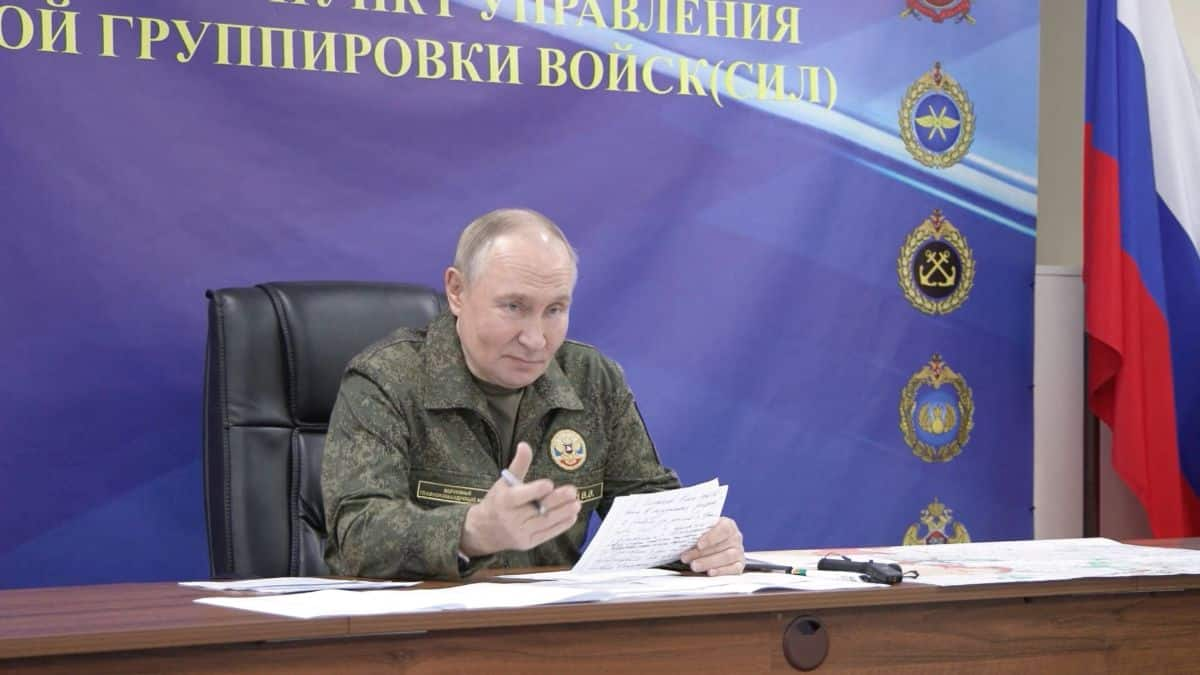Politics
Russia Claims Success in Testing Burevestnik Nuclear Missile

Russia has announced a successful test of the Burevestnik, a nuclear-powered cruise missile that President Vladimir Putin claims can evade any existing defence systems. The announcement, made on October 2023, is seen as a message to the West, emphasizing Russia’s resilience amid ongoing tensions surrounding the conflict in Ukraine. The missile test coincided with a comprehensive nuclear forces drill, showcasing Moscow’s military readiness at a time when diplomatic relations with the United States are strained.
During a meeting with military commanders, Putin, dressed in camouflage, stated that the Burevestnik successfully completed a major trial phase. He described the missile as a “unique weapon” that represents a new category of strategic armament. The test results indicated the missile flew for approximately 15 hours, covering a distance of around 14,000 kilometres (about 8,700 miles) using its nuclear propulsion system. General Valery Gerasimov, Chief of the General Staff of Russia’s Armed Forces, reported that the missile demonstrated capabilities to evade anti-missile and anti-aircraft defenses.
Putin noted that the successful test addressed previous doubts expressed by Russian specialists about the feasibility of such a weapon. He emphasized the need to determine how the Burevestnik will be integrated into Russia’s strategic arsenal. The missile, officially designated 9M730 Burevestnik, has been in development since its public announcement in March 2018. NATO refers to it as the SSC-X-9 Skyfall and describes its capabilities as distinct from conventional cruise missiles due to its nuclear-powered design.
The Burevestnik’s nuclear engine allows for extended airborne durations and intercontinental travel without refueling. The Nuclear Threat Initiative highlighted that the missile can evade detection while flying at low altitudes and strike targets unpredictably. According to the International Institute for Strategic Studies, it could theoretically reach up to 20,000 kilometres (approximately 12,400 miles1972 Anti-Ballistic Missile Treaty and expanded NATO’s presence in Eastern Europe. Putin has framed the Burevestnik as a necessary response to what he perceives as Western attempts to gain a first-strike advantage.
Russian military expert Alexei Leonkov suggested that the Burevestnik’s role is to target remaining enemy command centers and infrastructure after an initial nuclear exchange. He stated that after intercontinental ballistic missiles (ICBMs) neutralize primary defenses, Burevestniks would follow to complete the destruction.
While the missile is touted as a technological achievement, its development has faced significant challenges. Western intelligence sources noted failed tests since 2017, including a catastrophic accident during a 2019 test that resulted in the deaths of several Russian nuclear specialists. Although initial reports linked the incident to the Burevestnik program, Putin later acknowledged the sacrifices made in pursuit of this advanced technology.
Recent assessments indicate that researchers have identified a likely deployment site for the Burevestnik at a facility associated with nuclear warhead storage near Vologda-20, approximately 475 kilometres (about 295 miles) north of Moscow. Satellite imagery suggests preparations for handling nuclear-capable delivery systems.
The timing of the missile test coincided with heightened military activity in Ukraine, where Russian forces launched over 100 drones, resulting in civilian casualties. Ukrainian President Volodymyr Zelenskyy condemned the attacks, stating that they deliberately targeted civilians and residential areas. He reiterated the need for enhanced air defense systems to protect Ukrainian cities from ongoing assaults.
In Russia, local authorities reported injuries from Ukrainian strikes, while Moscow’s air defenses intercepted multiple incoming drones. The heightened military activity underscores the escalating tensions between Russia and Ukraine, alongside deteriorating relations with the United States, as diplomatic efforts face significant hurdles.
The announcement of the Burevestnik test serves both as a demonstration of military capability and a political statement, reinforcing Russia’s defiance in the face of international pressure. As relations between Moscow and Washington remain strained, the implications of this missile development will likely continue to shape the strategic landscape in the region.
-

 World3 months ago
World3 months agoSBI Announces QIP Floor Price at ₹811.05 Per Share
-

 Lifestyle3 months ago
Lifestyle3 months agoCept Unveils ₹3.1 Crore Urban Mobility Plan for Sustainable Growth
-

 Science3 months ago
Science3 months agoNew Blood Group Discovered in South Indian Woman at Rotary Centre
-

 Sports3 months ago
Sports3 months agoBroad Advocates for Bowling Change Ahead of Final Test Against India
-

 World3 months ago
World3 months agoTorrential Rains Cause Flash Flooding in New York and New Jersey
-

 Top Stories3 months ago
Top Stories3 months agoKonkani Cultural Organisation to Host Pearl Jubilee in Abu Dhabi
-

 Science3 months ago
Science3 months agoNothing Headphone 1 Review: A Bold Contender in Audio Design
-

 Top Stories3 months ago
Top Stories3 months agoAir India Crash Investigation Highlights Boeing Fuel Switch Concerns
-

 Sports3 months ago
Sports3 months agoCristian Totti Retires at 19: Pressure of Fame Takes Toll
-

 Business3 months ago
Business3 months agoIndian Stock Market Rebounds: Sensex and Nifty Rise After Four-Day Decline
-

 Politics3 months ago
Politics3 months agoAbandoned Doberman Finds New Home After Journey to Prague
-

 Top Stories3 months ago
Top Stories3 months agoPatna Bank Manager Abhishek Varun Found Dead in Well









